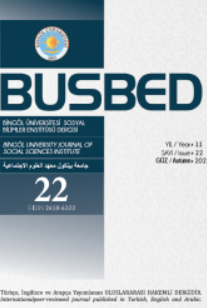DİEGO VELAZQUEZ’İN PAPA X. İNNOCENT ’İN PORTRESİ ADLI ESERİ BAĞLAMINDA SANATTA YİNELEME
INTERPRETATION IN THE ART IN THE CONTEXT OF DIEGO VELAZQUEZ'S PORTRAIT OF POPE INNOCENT X
Author(s): Figen GİRGİNSubject(s): Visual Arts, Aesthetics
Published by: Bingöl Üniversitesi Sosyal Bilimler Enstitüsü
Keywords: Repetition; Interpretation; Inspiration; Diego Velázquez; Pope Innocent X;
Summary/Abstract: Nature is the artist's greatest inspiration, and nature and humans are the dominant elements of art in the creative process. In addition, it is known that great artists benefit from the artworks of their pioneers and borrow the elements they need. In other words, during the formation process of an artwork, the artist chooses another work as the starting point. The artist determines what and how to get it according to his/her own needs. The artist interprets the artwork he/she has chosen as his inspiration according to his own artistic processing. In painting, it is difficult to determine how long the artists have chosen a work made before him/her as a source of inspiration. In painting, it is difficult to determine how long the artists have chosen an artwork made before him as a source of inspiration. Repetitions before contemporary art, even modern art, are mainly in the direction of the master-apprentice relationship. With the appreciation of the success of his/her predecessor or another artist in his/her time, the artist goes to it to analyse it and use it more educationally. However, contemporary art and later works can also be borrowed for different contents and meanings. One of the repetitions is Diego Velázquez's Pope Innocent X. This research is included the artworks of some artists who have chosen and repeated Velázquez’s Pope Innocent X. In this descriptive survey model research, according to the literature review and the works examined; It was sought to answer questions about how Pope Innocent X, Velázquez painted with realistic character analysis, was interpreted by the artists who followed him, why this artwork was chosen as an inspiration and how it was transformed. These examples and the questions sought to answer will provide an understanding of the conceptual dimension of contemporary art and how the past is reflected in the art of the present, as well as witnessing the dialogue one works with another.
Journal: Bingöl Üniversitesi Sosyal Bilimler Enstitüsü Dergisi (BUSBED)
- Issue Year: 11/2021
- Issue No: 22
- Page Range: 613-642
- Page Count: 30
- Language: Turkish

